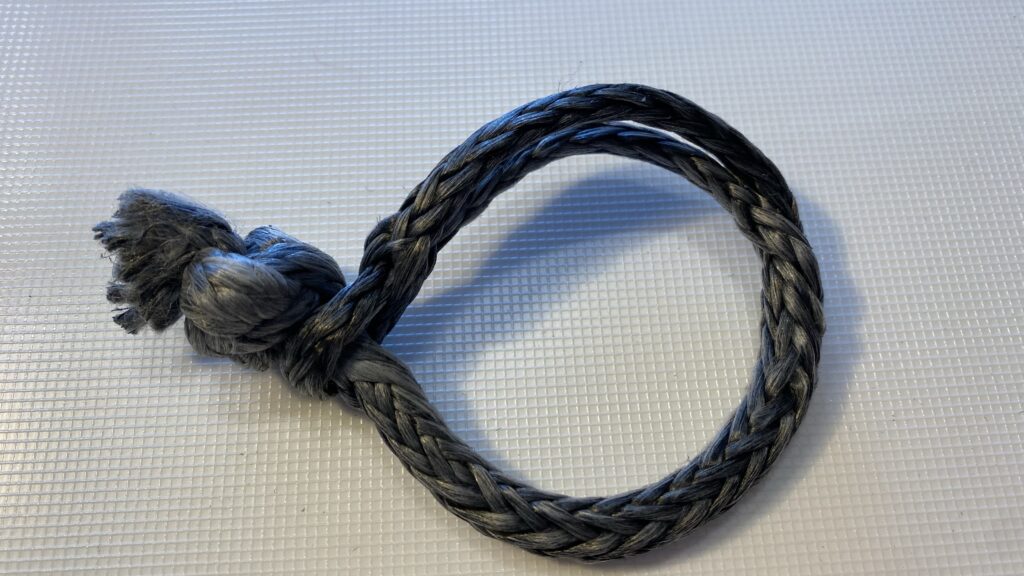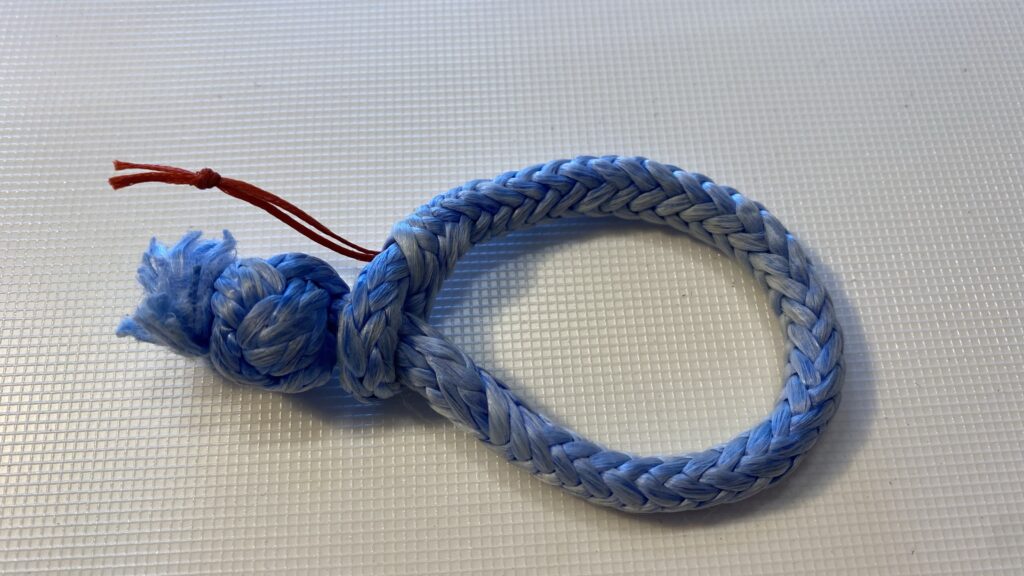What:
A soft shackle is a soft loop of strong, relatively thin rope, which can be opened. It functions like a shackle, but can be opened and closed faster (but slower than a snap shackle). Soft shackles can replace steel shackles on a sailboat. The biggest advantage is weight and handling. They are made of hmpe, or hmphe fiber, which per unit weight has five times the breaking strength of steel.
Where:
Running rig such as halyard and sheet terminals, aft stays, lifelines and sail fixings, among other things. Extra suitable aloft, where weight is at play for the righting moment in a sailboat.
Where not:
Some places in standing rigging (explained at length further down in the article). Places subjected to wear and tear like scratches and heavy mechanical wear. Your hands are a large part in the assessment of whether a soft tie should replace a steel shackle.
Don’t go totally nuts on weight. There may be handling reasons to prefer steel snap shackles for spinnaker terminals, despite the extra grams.
Also to consider is how often you open and close a shackle. On a sheet or halyard, often. On a lifeline, very rarely. On a stay, maybe once a season? You. could use a soft shackle on all, but maybe a lifeline is better off with a sizing at the ends. No diamond knot, or knob, so more elegant, right?



MAKE A SOFT SHACKLE, how to
Soft shackles can be bought, but it is entirely possible to make them yourself. The advantage is price, and that they can be custom made to exact measurements, thicknesses and use.
There are countless videos and photo series online that show the procedure. But not all soft shackles are equal.
Above you see pictures of three versions. Commercially, the most common ones right now have a drawstring to open it up. Wear quickly becomes apparent, as the rope is kind of «torn» open lengthwise every time it is opened. The loop also have to be milked back to close properly around their own knot – requiring two hands. I don’t like them much.
The shackle which is the easiest to make, has a double thread. Quite decent, but tends to open in its entire length, and can cause fiddling when in use. The good ones close themselves when they receive a load, and have a limited loop for the head when open. The odd one can also go totally bad, by wringing into itself, a situation you really don’t want during a kite set.
The top one is the good one, described in the following procedure. Enjoy!
YOU NEED:
HMPE rope 5mm
a sharp knife or very good scissors
a piece of wood for a cutting board
steel wire splicing needle (Possibly D-splicer or Selma Needle)
PROCEDURE for shackle (70 mm opening). In time, I will add photos according to the steps described here. By the way, apologies to the inch and foot part of the world, feel free to do conversions.
Cut a length of 90 cm 5 mm hmpe rope
Find and mark the middle
Split with the needle approx. 10mm from the mark. Make sure needle splits rope in equal halves.
Put one end through the hole.
Tighten loop around a pencil, screwdriver or piece of rope and adjust.
Measure out approx. 8 mm from first hole, split and pull second end through first
Bury end 1 inside 2 for a length of approx. 100 mm (hmpe is slippery. Bury should be 20-30 times diameter of rope)
Straighten and make a Carrick Bend
Extend Carrick Bend to Diamond Knot
Massage, straighten and tighten by hand until the knot is even roundish and hard.
Retighten if necessary with a screwdriver in a vise. The harder, the better
Cut the protruding ends about 10 mm from the knot
Note: A Button Knot may be even better than a Diamond Knot. Beware! A lot of versions out there. Here is a good one.
LENGTHS
By soft shackle length I’m talking about the internal length (diameter) of the loop formed in the locked position, stretched around two pins of about the same diameter as the rope diameter in question. I find that to be the most practical, but I of course realize that a shackle may be used around bigger or larger diameter pins, or thimbles or rope ends. This is one of the big advantage of being able to make soft shackles yourself. You can make it exactly as small or large, long or short, thick or thin, to fit a specific task. You can even color code them.
Example: A typical 65-70mm soft shackle is made from a length of 90 cm, 5mm rope. When opened, the shackle is approx. 150 mm long between the choke loop and the diamond knot. The knot itself steals about 100mm, while the ends you tighten the knot with (cut away afterwards) are about 150mm. This varies with how tight you manage to make the knot. You want it as hard as possible. All measurements times 2.
The diamond knot and the ends you cut away are constants in the calculation. If you are going to make a shackle with a different internal opening, only one measurement must be adjusted. Beware: Other rope thicknesses vary the measurements somewhat.
Dimensions to have on hand in a boat: 3 and 5 mm HMPE, most common in boats of our size. If you only have one dimension, go for 5 mm.
My experience: For shackles smaller than 60mm internal diameter, 3 mm HMPE rope works better.
Strength:
WHAT IS HMPE ROPE?
HMPE (High Modulus PolyEthylene) is a collective term for synthetic ropes with extra long – and thus extra strong – molecules.
The starting point is a UHMwPE (Ultra High Molecular weight PolyEthylene) fiber developed about 25 years ago. In recent years, the price has fallen, and the «exotic», extremely strong rope has become common property.
Stronger than steel, yet soft and kind to gelcoat, glasses, temples, teeth (!) and hands, or devices on the boat. HMPE ropes come in many variants, with greater and lesser breaking strengths, they stand up against abrasion and wear pretty well, but not as well as steel. And they come with different coatings better to cope with sunlight (UV), salt and weather.
The original gold standard was named SK38, made famous by producer Dyneema, later upgraded to SK75, SK78, and SK99. Each upgrade has resulted in an increase in breaking strength of around 25 per cent.
The standard describes a set of requirements for breaking strength, wear resistance and resistance to UV light. The higher the number, the stronger, less stretch and more resistant to sunlight and abrasion.
Spectra, Zylon and Amstel are producers of HMPE fiber rope materials. Many rope manufacturers, such as Marlow, Liros and Robline have their own designations.
The weight is one tenth of the corresponding diameter in steel. Straight from the spinning machine at the factory, the product behaves like a spring, but undergoes some pre-stretching or hot rolling before use. Many also get a coating of protection, both against mechanical impact and harmful sunlight.
Prices vary from fairly reasonable to a small country state budget.
HMPE fiber is finding its way into more and more areas of use, ashore or at sea. Everywhere you see a steel shackle on a sailboat, try to imagine a soft shackle instead. With every change you can get a few grams of weight overboard, optimizing your boat by those small increments. One will make no difference. But a hundred will.